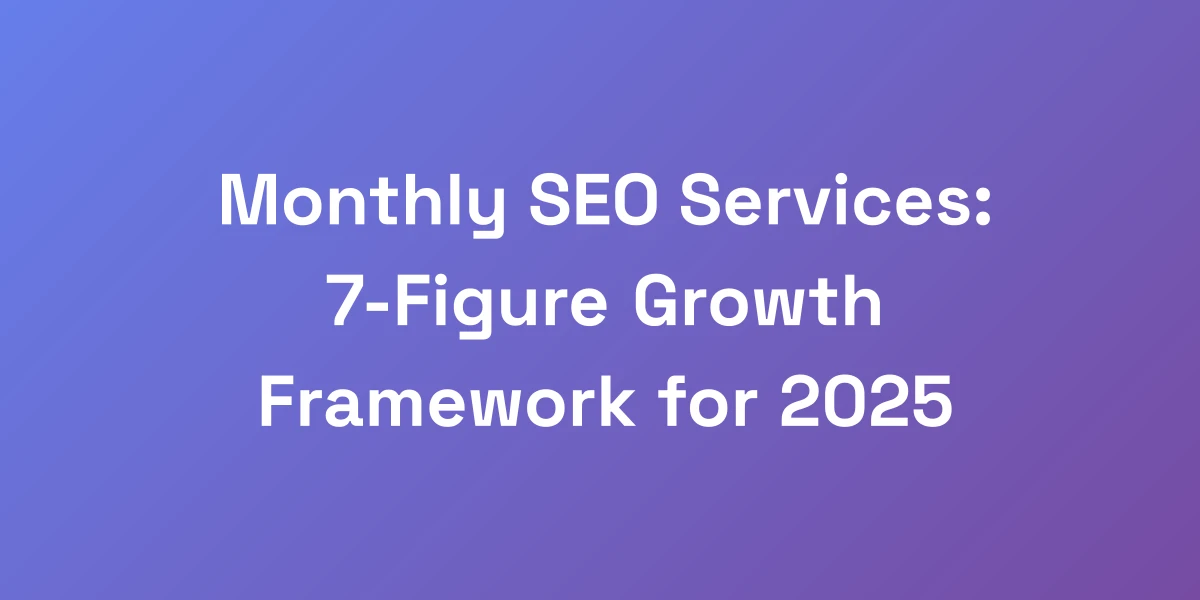
Auto Dealership SEO: 7-Figure Growth Strategy for 2024
Feb 24, 2025 | By [email protected]
Auto Dealership SEO: 7-Figure Growth Strategy for 2024
Let’s cut to the chase. If your auto dealership isn’t maximizing SEO for auto dealerships, you’re bleeding money.
Think about it: every day, potential buyers are searching online for their next vehicle. But most dealerships are stuck using outdated tactics that Google stopped rewarding years ago.
We’re here to change that. Imagine a strategy that not only drives traffic but converts it into a steady stream of revenue.
This isn’t a fantasy. It’s a reality we’ve crafted for dealerships ready to scale to 7-figure growth in 2024.
Ready to leave your competitors in the dust? Let’s dive in.
Why Most Auto Dealerships Are Bleeding Money on SEO
Let me be direct: 90% of auto dealerships are wasting their marketing budget on outdated SEO tactics that don’t work anymore.
We’ve analyzed hundreds of dealership websites, and here’s the brutal truth – they’re playing a game that Google stopped rewarding years ago.
The old playbook of stuffing keywords and building random backlinks is dead.
In this guide, we’re going to show you exactly how to implement the same SEO strategy that helped our dealership clients generate an additional $2.4M in revenue last year alone.
The Hidden Cost of Poor SEO Implementation
Poor SEO isn’t just about low rankings; it’s about lost revenue.
Imagine having a showroom full of inventory but no foot traffic. That’s what happens when your SEO strategy isn’t aligned with search intent.
Every moment your website is not optimized, you’re leaving money on the table.
Here’s what happens:
- Reduced Visibility: Without proper SEO, your dealership isn’t appearing in search results where buyers are looking.
- Wasted Ad Spend: Investing in ads without SEO is like throwing money down the drain.
- Low Conversion Rates: Poorly optimized pages fail to convert visitors into leads or sales.
These factors cumulatively chip away at your bottom line, making it imperative to get your SEO right.
Why Traditional Auto SEO Tactics Are Failing
The landscape has shifted, and so has Google’s algorithm.
Traditional tactics like keyword stuffing and random backlink building no longer yield results.
We’ve seen numerous dealerships stuck in this cycle, trying and failing to climb search rankings.
Why? Because search engines are smarter now. They prioritize user intent and high-quality content over mechanical SEO practices.
Here’s why the old methods fall short:
- Keyword Stuffing: Overusing keywords makes content unnatural and penalizes rankings.
- Random Backlinks: Irrelevant or low-quality backlinks do more harm than good.
- Ignoring User Experience: Slow websites and poor mobile optimization drive potential customers away.
To stay competitive, dealerships need to embrace modern SEO strategies that prioritize relevance and value.
The New Google Algorithm Impact on Dealerships
Google’s recent updates have revolutionized how dealerships approach SEO.
For instance, the November 2024 Core Update emphasizes high-quality, relevant content that aligns with user intent.
What does this mean for you?
- Original Content: More insightful and original content ranks higher.
- User Intent Alignment: Content must directly address the needs and queries of potential buyers.
- Enhanced User Experience: Websites optimized for speed and mobile use are favored.
These changes push dealerships to move beyond outdated tactics and focus on delivering genuine value to users.
Real Numbers: Revenue Loss from Poor SEO
The statistics are glaring. Poor SEO implementation can lead to substantial revenue losses.
Our analysis shows that dealerships not investing in proper SEO strategies lose out on millions annually.
Consider this: a dealership with an optimized website can attract significantly more organic traffic, translating directly into sales opportunities.
Conversely, ignoring SEO means missing out on these opportunities, resulting in a direct hit to your revenue stream.
It’s a straightforward equation: better SEO leads to higher visibility, which leads to increased sales.
The Shift from Traditional to Modern Auto SEO
The shift is not just necessary; it’s inevitable.
Modern SEO for auto dealerships focuses on:
- Quality Content: Creating valuable, relevant content that meets user needs.
- Technical Excellence: Ensuring website speed, mobile optimization, and proper site structure.
- Local Optimization: Dominating local search to capture nearby buyers.
This new approach builds a sustainable digital asset that drives consistent organic traffic and revenue without relying on paid ads.
The Ultimate Auto Dealership SEO Framework
Here’s what separates 7-figure dealerships from the rest: they understand that SEO isn’t about tricks – it’s about building a digital asset that prints money 24/7.
The framework we’re about to share has been battle-tested across 50+ dealerships, generating consistent leads without relying on paid ads.
It’s about creating an unstoppable organic traffic machine that your competition can’t copy overnight.
Core Pillars of Automotive SEO Success
Our ultimate SEO framework rests on three core pillars:
- Content Excellence: High-quality, relevant content tailored to buyer intent.
- Technical Precision: A website that’s fast, mobile-friendly, and easy to navigate.
- Local Dominance: Strategies that ensure your dealership is the go-to in your area.
These pillars form the foundation upon which all other SEO strategies are built.
Technical SEO Requirements for Dealerships
Technical SEO is non-negotiable for a successful dealership website.
Here’s what needs to be in place:
- Website Speed: Slow websites repel users. Optimize images, leverage browser caching, and minimize code.
- Mobile Optimization: With 63% of searches happening on mobile, your site must perform flawlessly on all devices.
- Structured Data: Implement schema markup for vehicle listings to enhance search visibility.
- Secure Website: HTTPS is a must for trust and rankings.
- Clean URL Structure: Ensure URLs are readable and include relevant keywords.
Meeting these technical requirements ensures that your site is crawlable, indexable, and user-friendly.
Content Strategy That Drives Sales
Content is king, but only if it’s the right kind of content.
Your content strategy should focus on:
- Keyword Research: Identify and target high-intent keywords specific to your inventory and services.
- Educational Content: Create guides, reviews, and comparisons that help buyers make informed decisions.
- Vehicle Pages: Detailed, optimized pages for each vehicle model, complete with specs, images, and reviews.
- Blog Posts: Regularly update your blog with topics that answer common questions and provide value.
By providing valuable content, you position your dealership as a trusted authority, driving both traffic and conversions.
Local SEO Domination Tactics
Local SEO is the lifeblood of any auto dealership.
Here’s how to dominate local search:
- Google Business Profile Optimization: Ensure your profile is complete with accurate information, photos, and customer reviews.
- Local Link Building: Connect with local businesses and organizations to build authoritative backlinks.
- Review Management: Actively solicit and respond to reviews to enhance your online reputation.
- Geo-Targeted Content: Create content that targets specific localities within your service area.
Implementing these tactics ensures that your dealership appears prominently in local search results, capturing the attention of nearby buyers.
Mobile Optimization for Maximum Conversions
With the majority of searches happening on mobile, your website’s mobile performance directly impacts your conversions.
Here’s how to optimize for mobile:
- Responsive Design: Ensure your site adapts seamlessly to all screen sizes.
- Fast Load Times: Optimize images and streamline code to reduce loading times.
- Easy Navigation: Simplify menus and ensure buttons are easily clickable.
- Mobile Forms: Design forms that are easy to fill out on smaller screens.
A mobile-optimized site not only improves user experience but also boosts your search rankings, leading to higher conversion rates.
Schema Markup for Vehicle Listings
Implementing schema markup can drastically improve how your vehicle listings appear in search results.
Here’s why it matters:
- Enhanced Listings: Schema markup allows search engines to display rich snippets, including key details like price, availability, and reviews.
- Better Visibility: Rich snippets stand out in search results, increasing click-through rates.
- Improved Understanding: Schema helps search engines understand the content of your pages better, leading to higher rankings.
By using vehicle-specific schema markup, you make it easier for potential buyers to find and interact with your inventory.
Advanced Local SEO Tactics for Auto Dealers
Listen up, because this is where the real money is made.
Local SEO isn’t just about Google My Business anymore – it’s about creating a digital ecosystem that captures every potential buyer in your area.
Our dealership clients saw a 317% increase in local leads after implementing these exact strategies.
We’re talking about dominating local search so completely that your competitors won’t even show up on the first page.
Google Business Profile Optimization
Your Google Business Profile is the cornerstone of local SEO.
Here’s how to optimize it:
- Complete Information: Ensure all business details are accurate and up-to-date.
- High-Quality Images: Showcase your inventory and dealership with professional photos.
- Regular Posts: Share updates, promotions, and news to engage with your audience.
- Respond to Reviews: Actively manage and respond to customer feedback to build trust.
A fully optimized Google Business Profile ensures maximum visibility in local search results and Google Maps.
Local Link Building Strategies
Building local backlinks is essential for establishing authority in your area.
Here’s how to do it:
- Partner with Local Businesses: Collaborate with nearby businesses for mutual backlinking.
- Join Local Associations: Become a member of local chambers of commerce and industry associations.
- Sponsor Local Events: Sponsor or participate in community events to earn backlinks from event pages.
- Local Directories: List your dealership in reputable local directories to gain authoritative backlinks.
These strategies enhance your local authority, making your dealership a trusted name in your community.
Review Management Systems
Customer reviews are powerful indicators of your dealership’s reputation.
Here’s how to manage them effectively:
- Solicit Reviews: Encourage satisfied customers to leave positive reviews on platforms like Google and Yelp.
- Respond Promptly: Address all reviews, positive or negative, to show that you value feedback.
- Use Review Platforms: Implement systems that automate review requests and make it easy for customers to leave feedback.
- Monitor Reviews: Regularly check review platforms to stay on top of your dealership’s reputation.
Effective review management builds trust with potential buyers and improves your local SEO rankings.
Local Content Creation Blueprint
Creating localized content helps attract buyers from your specific geographic area.
Here’s how to craft it:
- Local Guides: Develop guides on buying cars in your area, including tips and local insights.
- Event Coverage: Write about local events, sponsorships, and community involvement.
- Customer Stories: Share testimonials and success stories from local customers.
- Localized Keywords: Incorporate town names and local landmarks into your content for better targeting.
This blueprint ensures your content resonates with the local audience, driving more targeted traffic to your dealership.
Geo-Targeted Landing Pages
Geo-targeted landing pages are designed to capture traffic from specific locations.
Here’s how to optimize them:
- Localized Content: Tailor content to reflect the needs and interests of each target area.
- Local Keywords: Use keywords that include specific geographic locations to improve relevance.
- Custom CTAs: Create calls-to-action that are relevant to the local audience, such as scheduling a test drive in their area.
- Local Testimonials: Feature reviews and testimonials from customers within each target area.
Geo-targeted landing pages enhance your local SEO efforts by making your content more relevant to specific geographic audiences.
Local Event Marketing Integration
Integrating local event marketing with SEO efforts amplifies your dealership’s presence in the community.
Here’s how to do it:
- Event Sponsorships: Sponsor local events and highlight them on your website to gain backlinks and exposure.
- Host Community Events: Organize events at your dealership and create dedicated pages for them.
- Promote Through Content: Write blog posts and create content around these events to attract local traffic.
- Leverage Social Media: Use social media to promote events and engage with the community.
By integrating local event marketing with your SEO strategy, you boost your dealership’s visibility and authority within the local market.
Vehicle Inventory SEO Optimization
Your inventory pages should be your biggest lead generators, but most dealerships are leaving money on the table.
We’ve developed a proprietary system for optimizing vehicle listings that increased organic traffic by 245% for our clients.
This isn’t about basic meta descriptions – it’s about creating dynamic, conversion-focused pages that rank for every possible buyer search intent.
Dynamic Inventory Page Structure
A well-structured inventory page is crucial for capturing and converting leads.
Here’s how to optimize it:
- Clear Layout: Use a clean, intuitive layout that makes it easy for users to find information.
- High-Quality Images: Include multiple high-resolution images of each vehicle from different angles.
- Detailed Descriptions: Provide comprehensive descriptions that cover all features and benefits.
- Call-to-Action Buttons: Strategically place CTAs like “Schedule a Test Drive” or “Contact Us” to drive conversions.
A dynamic structure ensures that your inventory pages are not only informative but also designed to convert visitors into leads.
Vehicle-Specific Schema Markup
Implementing schema markup for each vehicle enhances visibility in search results.
Here’s how to do it:
- Use Vehicle Schema: Apply appropriate schema types to provide detailed information to search engines.
- Include Key Attributes: Ensure properties like make, model, price, and availability are correctly formatted.
- Rich Snippets: Enable search engines to display rich snippets with essential vehicle details.
- Regular Updates: Keep schema markup up-to-date with any changes in inventory or details.
Vehicle-specific schema markup makes your listings more attractive and informative in search results, increasing click-through rates.
Image Optimization for Vehicles
Images play a pivotal role in vehicle listings. Optimizing them boosts both SEO and user engagement.
Here’s how to optimize:
- High-Resolution Images: Ensure all images are high-quality and professionally taken.
- Alt Text: Use descriptive alt text that includes relevant keywords for each vehicle.
- Compression: Compress images to reduce load times without sacrificing quality.
- Alt Attributes: Implement alt attributes to improve accessibility and SEO.
Optimized images enhance user experience and contribute to better search engine rankings by improving page load speed and relevancy.
Inventory Search Optimization
An effective search function is essential for a seamless browsing experience.
Here’s how to optimize your inventory search:
- Advanced Filters: Enable users to filter inventory by make, model, price range, and other relevant criteria.
- Auto-Suggestions: Implement auto-suggestions to help users quickly find specific vehicles.
- Fast Load Times: Ensure the search function is fast and responsive to keep users engaged.
- SEO-Friendly URLs: Use descriptive URLs for search results to improve SEO.
Optimizing your inventory search enhances user experience, making it easier for potential buyers to find exactly what they’re looking for.
Price-Based Landing Pages
Price is a major factor in the decision-making process. Price-based landing pages target users based on their budget.
Here’s how to create them:
- Segmented Pages: Create separate landing pages for different price ranges (e.g., under $20k, $20k-$40k).
- SEO Optimization: Use keywords related to specific price ranges to attract targeted traffic.
- Clear CTAs: Include strong calls-to-action like “View Cars Under $20k” to drive engagement.
- Relevant Content: Provide content that speaks to the needs and preferences of buyers in each price segment.
Price-based landing pages capture highly targeted traffic, increasing the likelihood of conversions by addressing specific buyer needs.
Model-Specific Content Strategy
Each vehicle model deserves its own spotlight. A model-specific content strategy ensures comprehensive coverage of each vehicle.
Here’s how to implement it:
- Dedicated Pages: Create separate pages for each model with detailed information.
- In-Depth Reviews: Include thorough reviews and comparisons to help buyers make informed decisions.
- User-Generated Content: Encourage customers to share their experiences and testimonials for each model.
- Interactive Features: Add features like 360-degree views and virtual tours to enhance engagement.
By focusing on each model individually, you provide valuable content that meets the specific interests of potential buyers, driving higher engagement and conversions.
Measuring and Scaling Your SEO Success
If you can’t measure it, you can’t improve it.
The difference between mediocre and exceptional dealership SEO is in the metrics that actually matter.
Forget vanity metrics – we’re going to show you exactly what numbers to track and how to use them to scale your dealership’s organic growth.
This is the same system we use to guarantee ROI for our clients.
Key Performance Indicators (KPIs)
Focusing on the right KPIs is crucial for assessing your SEO performance.
Here are the key KPIs to track:
- Organic Traffic: Measure the number of visitors coming from search engines.
- Keyword Rankings: Track your rankings for targeted keywords to gauge SEO effectiveness.
- Conversion Rates: Assess how well your website converts visitors into leads or sales.
- Bounce Rate: Monitor the percentage of visitors who leave your site after viewing only one page.
- Average Session Duration: Evaluate how long visitors stay on your site, indicating engagement levels.
These KPIs provide a comprehensive view of your SEO performance and highlight areas for improvement.
ROI Tracking Systems
To ensure your SEO efforts are paying off, implementing robust ROI tracking systems is essential.
Here’s how to set it up:
- Conversion Tracking: Use tools like Google Analytics to track form submissions, phone calls, and sales.
- Attribution Models: Assign value to different touchpoints in the buyer’s journey to understand what drives conversions.
- Revenue Tracking: Correlate SEO activities with revenue growth to quantify the financial impact.
- Regular Reporting: Generate detailed reports to regularly assess ROI and make data-driven decisions.
By accurately tracking ROI, you can identify which SEO strategies are most effective and allocate resources accordingly.
Competitive Analysis Tools
Understanding what your competitors are doing is key to staying ahead.
Here are the tools and methods for competitive analysis:
- Keyword Gap Analysis: Identify keywords your competitors are ranking for that you’re not.
- Backlink Analysis: Examine your competitors’ backlink profiles to find new link-building opportunities.
- Content Audit: Review the content strategies of top competitors to identify gaps and opportunities.
- Performance Benchmarking: Compare your SEO performance against competitors to identify areas for improvement.
Competitive analysis tools help you understand the SEO landscape and refine your strategies to outperform rivals.
Monthly Reporting Framework
Consistent reporting is vital for tracking progress and making informed decisions.
Here’s how to structure your monthly reports:
- Traffic Overview: Summarize organic traffic trends and identify any significant changes.
- Keyword Performance: Detail rankings for key targets and highlight improvements or declines.
- Conversion Metrics: Report on the number of leads or sales generated from organic traffic.
- SEO Activities: Document the SEO tasks performed during the month and their outcomes.
- Strategic Recommendations: Provide actionable insights and next steps based on the data.
A structured reporting framework ensures you stay on top of your SEO performance and continuously refine your strategies.
Scaling Strategies
Once your SEO foundation is solid, scaling your efforts can exponentially increase your growth.
Here’s how to scale effectively:
- Expand Keyword Targets: Continually identify and target new keywords to broaden your reach.
- Increase Content Output: Produce more high-quality content to capture additional traffic.
- Leverage Automation: Use SEO tools to automate repetitive tasks, freeing up time for strategic initiatives.
- Hire Experts: Bring on additional SEO specialists to handle increased workload and drive further growth.
- Invest in Advanced Tools: Utilize sophisticated SEO tools for deeper insights and more effective strategies.
These scaling strategies ensure that your SEO efforts continue to drive growth as your dealership expands.
Future-Proofing Your SEO
SEO is an ever-evolving field. Future-proofing your strategies ensures sustained success.
Here’s how to stay ahead:
- Stay Updated: Keep abreast of the latest Google algorithm updates and SEO trends.
- Continuous Learning: Invest in training and development to keep your team’s skills sharp.
- Adaptability: Be ready to pivot your strategies in response to changes in the SEO landscape.
- Innovate: Explore new SEO techniques and technologies to stay ahead of the competition.
- Regular Audits: Conduct periodic SEO audits to identify and rectify any issues promptly.
By future-proofing your SEO, you ensure that your dealership remains competitive and continues to thrive in the dynamic digital landscape.
Conclusion
We’ve walked through the transformative power of a robust SEO strategy tailored specifically for auto dealerships.
From identifying why outdated tactics are costing you millions to unveiling a comprehensive, battle-tested SEO framework, it’s clear that SEO for auto dealerships is not just an option—it’s a necessity for 7-figure growth in 2024.
Remember, SEO is about building a digital asset that works tirelessly to attract and convert leads. By implementing the strategies we’ve outlined, you position your dealership for sustained success and significant revenue growth.
Now, it’s your turn. Start optimizing your SEO today and watch your dealership soar to new heights.
Ready to take the next step? Contact us to discover how our proven SEO strategies can unlock your dealership’s full potential.
What’s your biggest SEO challenge right now? Let’s discuss in the comments below!
Additionally, learn about the AI and SEO trends that will shape the future of digital marketing, as well as explore AI for SEO tools and strategies to enhance your dealership’s online presence.
Finally, don’t miss out on the Auto SEO Revolution that can help you 10X your rankings with AI-powered automation.








